Features and cultivation of marjoram

Marjoram is a worldwide spice famous for its aroma. About how it looks, what it happens, what are the main nuances of its cultivation and care, read on.
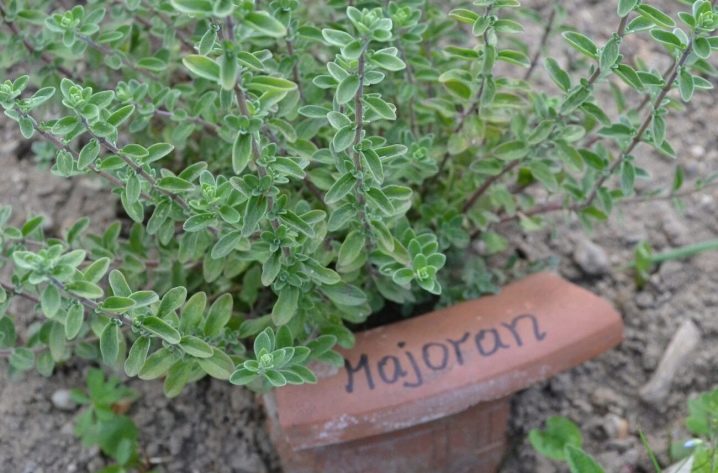
What it is?
Marjoram is a perennial herb of the Origanum genus, the Yasnotkov family. Its other names are mardakush, mess, scent, southerner, garden oregano.
In Germany, the common people call it sausage grass. Translated from the Latin, origanum majorana means “big oregano”. Marjoram can be wild (leaf) and garden (flowering).
Shades of flower varieties are pink, white, reddish, pinkish-lilac. Flowers are collected in inflorescences in the form of panicles or half panicles.
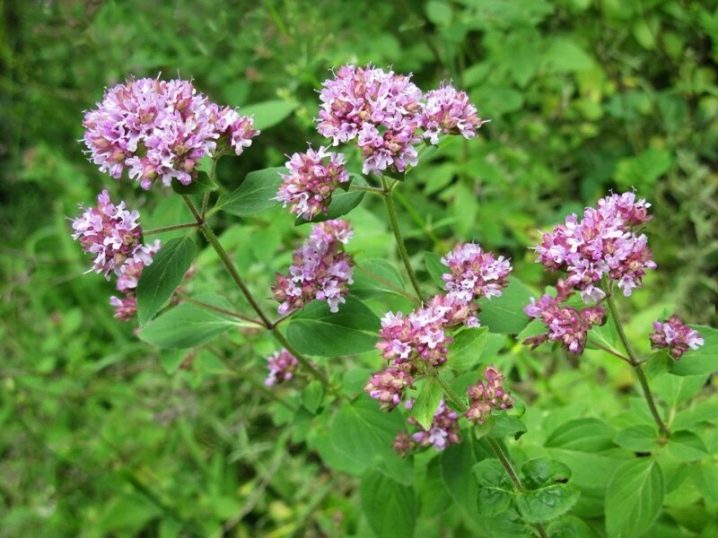
The leafy marjoram is considered a wild perennial. Can be grown as an annual. Differs in powerful stems. The flower (garden) type is a cultivated plant, it has fewer leaves, more panicles.
Depending on the variety, it has straight and branched shoots. Their height ranges from 20 to 50 cm. In some cases, the plant reaches a height of 70 cm. Its stems are woody at the base.
Leaves, depending on the variety, are not only different shades of green, but also green-blue and even silvery. From above, they are covered with the finest gray villi or a silvery coating.
The shape of the leaf blades located on the cuttings is usually oblong, ovoid. Sometimes it is close to the shape of a shovel with a rounded end.
Marjoram is considered a medicinal herb, it has healing properties. It is used to treat various diseases. With proper care, it reaches a height of about 1 m.
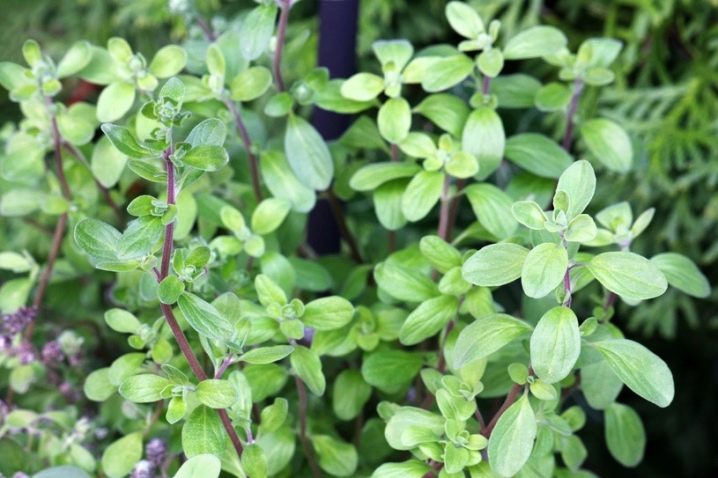
Varieties
Several varieties of the spicy plant are in demand in horticulture. They are rich in essential oils that reach their maximum concentration during the growing season. Saturated with vitamins, macro-, microelements.
"Garden Baikal"
This variety is included in the Rosreestr of Russia. It is planted in open ground, is a perennial shrub. It grows up to half a meter in height, has a diameter of about 40 cm.
Erect, has about 20-50 stems. In the middle lane, it is grown as an annual. The growing season is 170–180 days. Prefers fertile soils in sunny areas.
Especially productive, has white flowers and small smooth green leaves. It has a strong aroma.
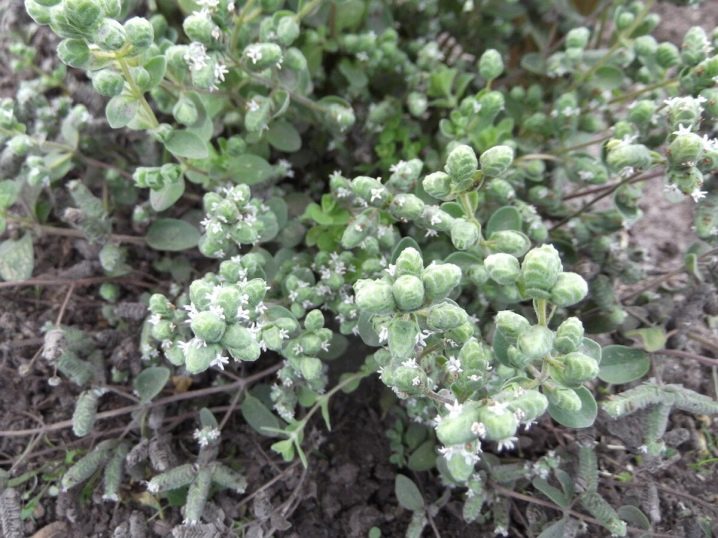
"Cretan"
This variety is popular for its characteristic lemon flavor. Differs in a pinkish-lilac shade of flowers. They are large and hanging.
The Cretan variety has dense bluish leaves. Its height ranges from 30 cm to 1 m. The stems are powerful, the leaves are rounded, and have silvery pubescence. The inflorescences are hidden under the larger bracts of a pinkish-green tone. Peduncles are flexible.
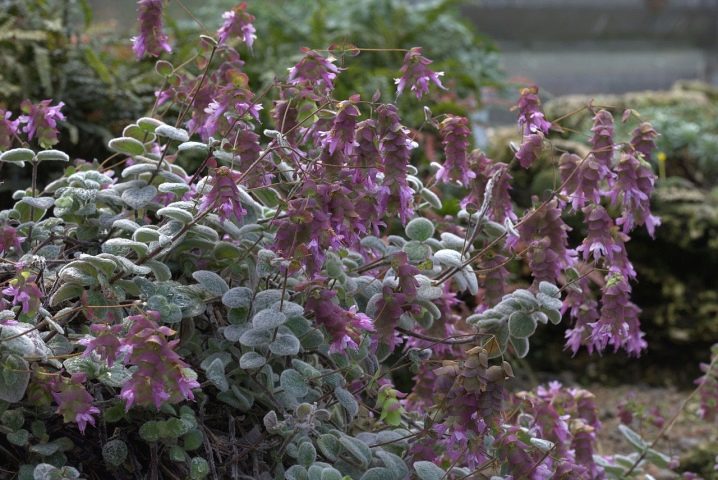
"Scandi"
This variety belongs to large semi-branched semi-shrubs. It has light green foliage, whitish buds, and a pronounced aroma. Leaves are oval, green, without wax bloom.
The ripening period is about 4 months. Grown for essential oils. Reaches a height of 60 cm to 1 m, is distinguished by strong branching, power of shoots. Has white flowers.
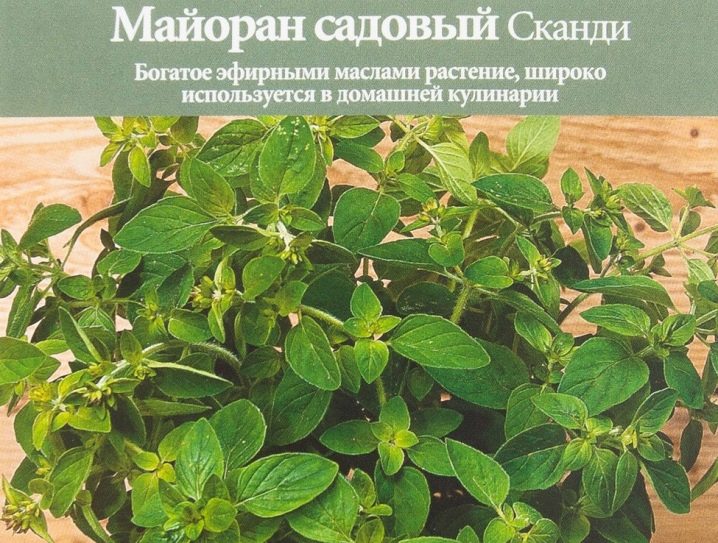
"Gourmet"
This variety is widely demanded in cooking. The herb is used in the preparation of salads, seasonings, sauces, sausages. The variety is high-yielding, undersized.
Differs in an ovoid shape of green leaf plates. The average height in the regions is 20 cm. The leaves are dense, smooth, bright green. Collectable within 3 months of disembarkation.

"Thermos"
"Thermos" refers to light-loving food varieties about 40 cm high. It has large green-blue or green-grayish leaves, numerous small white flowers.
Stems are powerful, erect, foliage is lowered. The yield of greenery is 0.6-1 kg / m2. Drought-resistant variety, late summer honey plant. Grown as an annual, it has a strong spicy aroma.
Grown in 50-60 day old seedlings. Seedlings appear in 2-3 weeks in well-warmed areas.
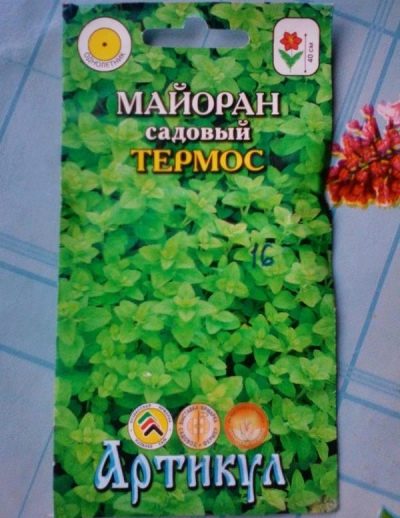
Landing
Growing grass at home is easy. The plant needs a well-lit and drained area. It can be grown from seeds or by seedling.
Marjoram can be planted at home in the garden or in containers. The plant is also grown on a windowsill in pots, using its greens as a seasoning for various dishes.
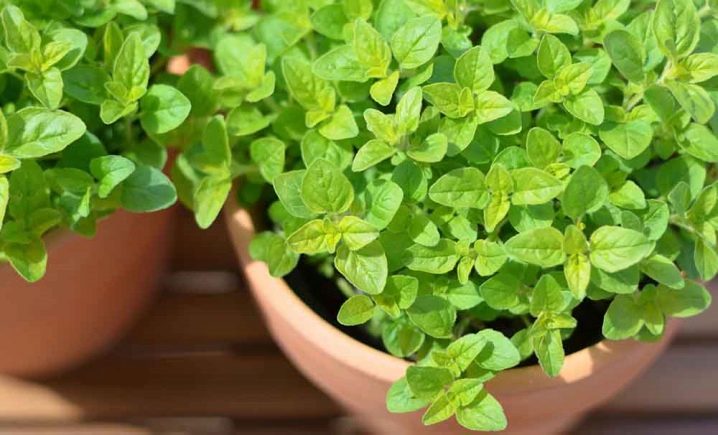
When planting in open ground, the soil is preliminarily prepared. To do this, they dig up or plow the garden bed, saturating it with mineral fertilizer.
Shortly before landing, ammonium nitrate is introduced into the ground at the rate of 0.15 kg per 1 m2. The seeds are mixed with sifted river sand. After that, they are sown, deepening into the ground by 1–2 cm.
The row spacing is about 70 cm. The average growing time is about 2 weeks at temperatures from +12 to +15 degrees. At this stage, the sprouts are thinned out at intervals of 10 cm.
The plant can be propagated by cuttings. For this, bushes of 3 and 5 years of age are used. This method is considered particularly cost-effective.
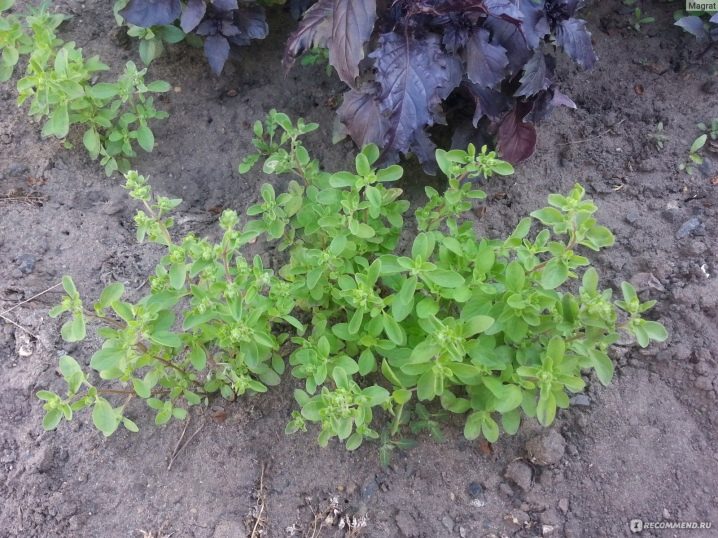
When choosing a seedling planting method, seeds should be sown in prepared soil 6-7 weeks before planting in open ground. They are buried no more than 3 mm, sprinkled on top with soil through a sieve.
Further, they maintain comfortable conditions for germination. They monitor the maintenance of the required humidity level. Do not allow the soil to dry out.
The optimal time for planting seeds is April. Before emergence, containers are covered with plastic wrap. When the first shoots begin to be seen, it is removed.
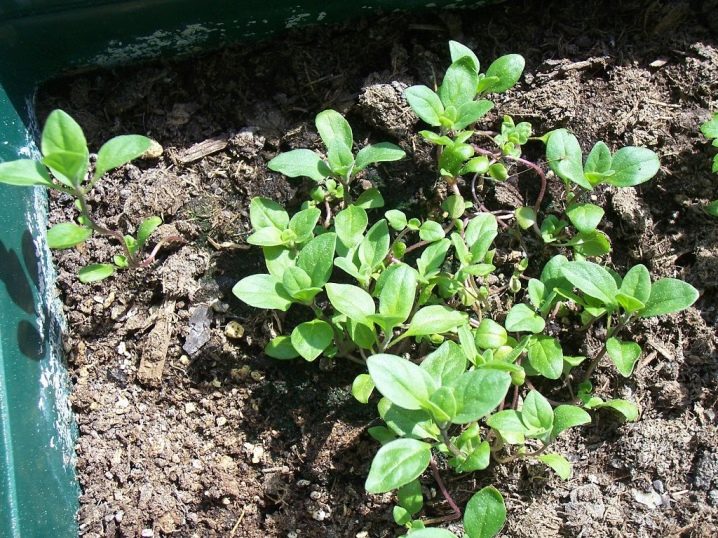
If marjoram is grown in an apartment, prepare containers with a volume of 1.5 liters, a moisture-consuming substrate consisting of equal shares of humus, turf, sand. Drainage is equipped with expanded clay or gravel. At the bottom of each pot there should be at least 2-3 holes for water drainage.
At home, the grown plant can be sown at any time of the year. However, spring and early summer crops are considered the most profitable. Before planting in the ground, you need to prepare the seed. For this, the seeds are soaked in a weak solution of potassium permanganate. This is done to prevent possible fungal infections.
The use of plastic wrap speeds up the germination time by one and a half times.
After the material is removed, the containers are placed in a well-lit place.
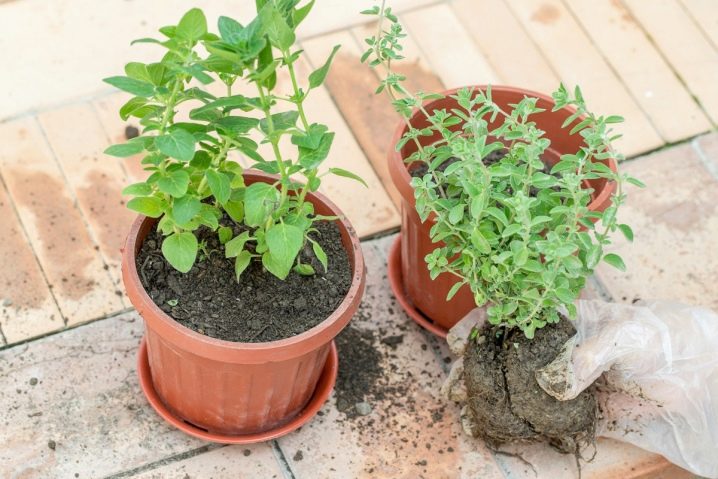
Growing conditions
Growing marjoram depends on the observance of the basic rules of temperature, illumination, and humidity levels. The plant reacts to any uncomfortable conditions.
When growing seedlings, a pick is made in a timely manner. This is done at the stage when the seedlings will have the first pair of true leaves. The distance between them must be at least 5 cm.
In open ground, seedlings are placed only after the establishment of warm weather. If frosts are still possible in the region, the plant will die. Marjoram takes root well in a new place. It should be well warmed up and illuminated. Shading reduces not only the yield, but also the aroma of the crop.
The soil type can be light, medium-calcareous, supplied with organic fertilizer. Ideal conditions are slightly acidic or neutral soil with humus.
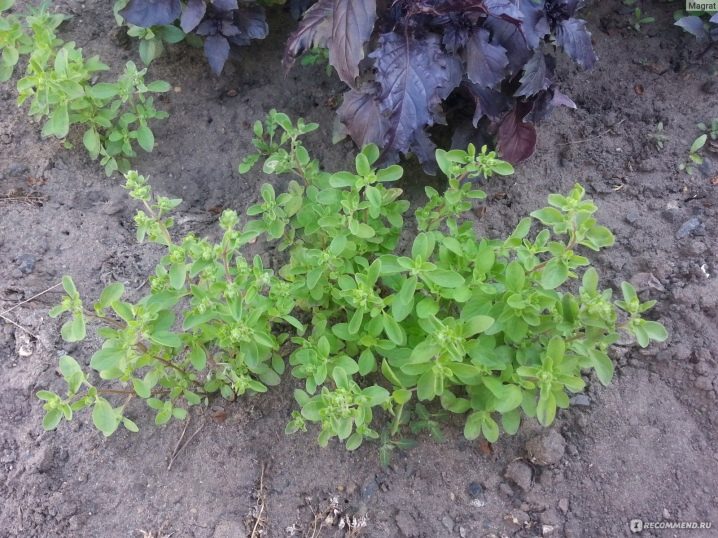
It is better to plant marjoram in the garden where potatoes, cabbage, onions, beans, peas, tomatoes used to grow. In the spring, you can fertilize the site with ammonium nitrate.Marjoram is responsive to feeding.
In cold climates, marjoram grows in a greenhouse. Despite its unpretentiousness, it is vulnerable to frost. Well cultivated, blooms on average for about two months.
It is easier to grow a garden type of plant. Its shoots grow faster, it ripens earlier and can be used for cooking. It contains many vitamins. The best type of landing in a permanent place is in-line, with sufficient distance from each other.

Temperature
Marjoram is a thermophilic plant. Seedlings feel great at temperatures from +20 to +25 degrees. It grows well in the country at temperatures from +15 to +20 degrees. The night indicator can drop to +14 degrees.
When the temperature drops to -2 degrees, the seedlings die. At low positive values, their growth stops, the marjoram falls into a state of oppression. If the temperature is too high, the shoots will stretch out and then dry out. If it is optimal, the bushes grow dense and squat.
The growth of green mass stops at a temperature of +10 degrees. The first autumn frosts are destructive, so you need to collect greens and flowers in advance.

Lighting
It is important to plant the crop in a well-lit area, protected from drafts. It is quite lush and bushy, the distance between the bushes should be sufficient to receive sunlight.
You need to grow no more than 6 bushes per 1 m2. Marjoram is planted in a permanent place at the end of May. At this time, the seedlings already have 5-6 true leaves. When grown in an apartment or greenhouse with a lack of light, fluorescent lamps are used. If the marjoram grows on a windowsill, it is best to move the pot to a south-facing window.
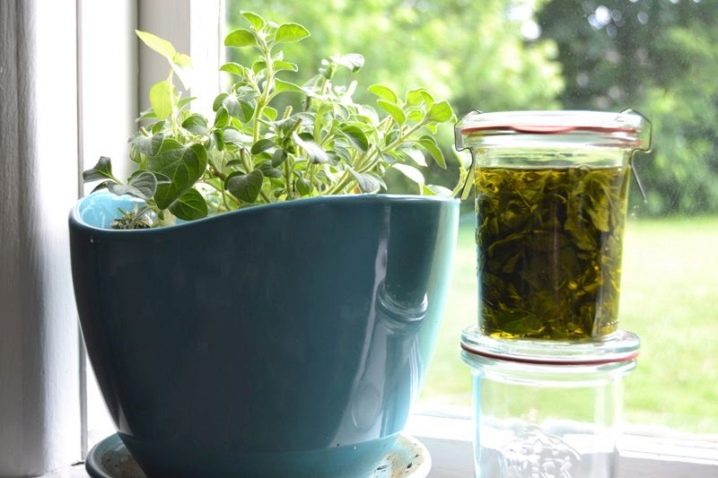
Humidity
Marjoram is a moisture-loving crop. It must be watered regularly and often. It is better to moisturize the sprouts in the morning or after sunset. For watering seedlings, you need to use warm water heated in the sun.
Around the middle of summer, the frequency and volume of irrigation are reduced. The need for moisture is signaled by a dried topsoil. After moistening, the root zone is loosened. Do not wait until the soil is very dry.
When watering plants grown on a windowsill, before the procedure, you must first defend the water. It contains chlorine, which destroys the plant, negatively affects its growth. Do not pour rusty water on the marjoram.
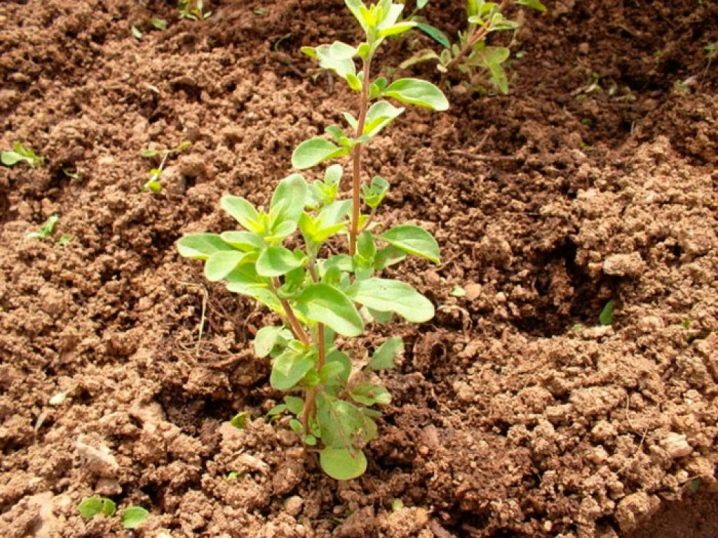
Care
Marjoram care consists in timely watering, weeding, loosening the earth in the garden or summer cottage garden. The first few days after transplanting to a permanent place, you need to protect the plant from direct sunlight. Do not plant sprouts in the heat: this will increase the rooting period.
Approximately 3 weeks after planting the seedlings in a permanent place, you need to feed the culture with a complex of fertilizers. Potassium salt, urea and superphosphate must be added to the ground.
This is quite enough for comfortable growth and development of bush marjoram. However, some gardeners feed the crop twice in the summer using mineral fertilizers.
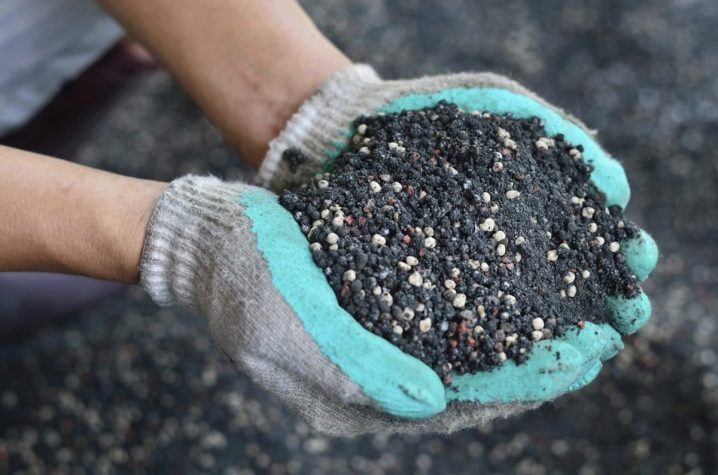
If the soil is poor, the frequency of fertilizing increases. Before flowering, you can fertilize the plant with "Kemira" or wood ash. Do not feed with an overly concentrated solution: this leads to severe burns. Do not exceed the dosage of the selected fertilizer.
When using special preparations, they are bred according to the instructions on the package. If a plant is fertilized with a mineral complex, it must be alternated with organic matter.
To get a larger volume of greenery, the peduncles are cut off before the growing season. If you wish, you can wait until the fragrant flowers appear.
This is exactly what gardeners do when they use flowers for medical and culinary purposes. The first crop can be harvested at the end of July. The greens are cut for the second time in late August - early September.
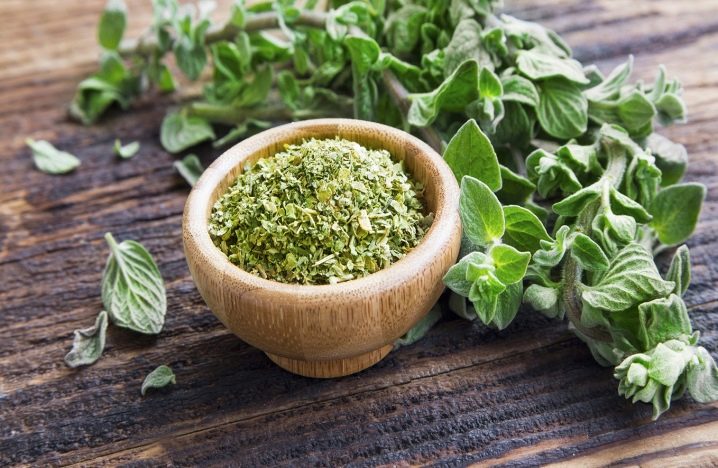
Diseases and pests
Often, the diseases that a culture faces can be cured early on. Pest attacks will weaken the marjoram. The later the disease is detected, the longer is the rehabilitation time after treatment.
The most common problem for young plants is Alternaria. The disease can be detected by stopping the growth of bushes and the appearance of spots on the leaf plates. The main causes of Alternaria are dampness and thickening of the planting. To solve the problem, marjoram is treated with a fungicidal preparation.
One of the diseases is root rot. Usually it occurs due to systematic waterlogging of the soil in the root zone. This may appear due to the lack of a drainage system or an incorrect irrigation regime. To save the plants, you need to place them in another place, slightly damp.
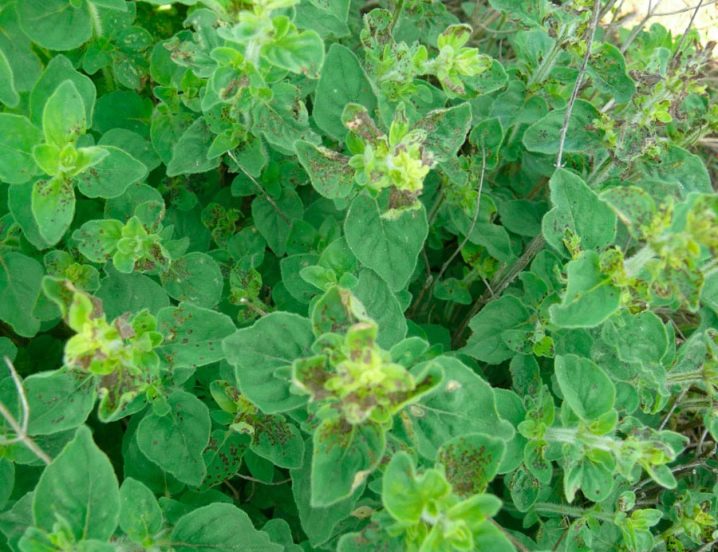
Sometimes gardeners note that marjoram's lower leaves die off. This is due to a lack of moisture. Watering alone will not do. To restore health, you will have to add nitrogen fertilization to the soil. If the volume of dead foliage is large, the bare stems are completely cut off.
Despite the sharp spicy aroma, the plant is attacked by harmful parasites. One of the annoying ill-wishers is the spider mite. It feeds on the sap of the leaves, which depletes the entire bush. The characteristic signs of his stay are the presence of cobwebs, dryness and depletion of the green mass, its yellowness and shedding.
To get rid of small parasites, you need to use a special drug - acaricide. The use of conventional insecticidal agents in the fight against spider mites is ineffective. You can treat the bush with Actellik. To forget about the spider mite forever, the action is repeated about 10 days after the first procedure.
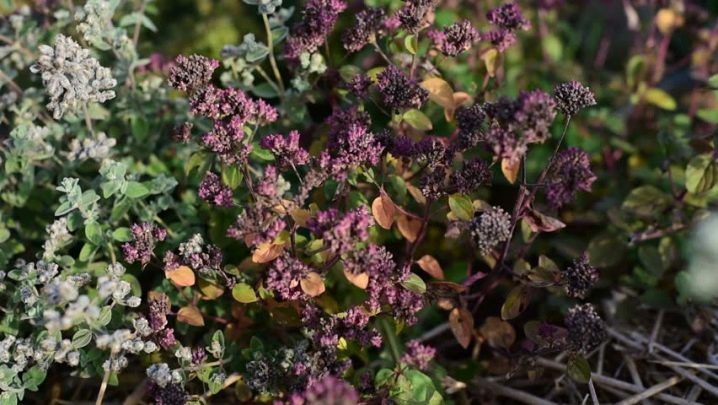
Aphids also belong to lovers of juice from marjoram leaves. It settles on the bottom of the leaf plates, pierces tiny holes in them and draws out all the juices.
Symptoms of the disease are expressed in the form of dryness, deformation, leaf curl. In addition, aphids produce a sticky liquid. If the lesion is small, treatment of the plant with a solution of laundry soap helps.
If the colony is too large, you will have to use an insecticide. Aktara will do. This product is odorless and has a long-lasting protective effect. Occasionally, the plant is affected by the marjoram moth. The parasite feeds on leaves. To get rid of it, you need to spray the plant and the soil under it with an insecticide.
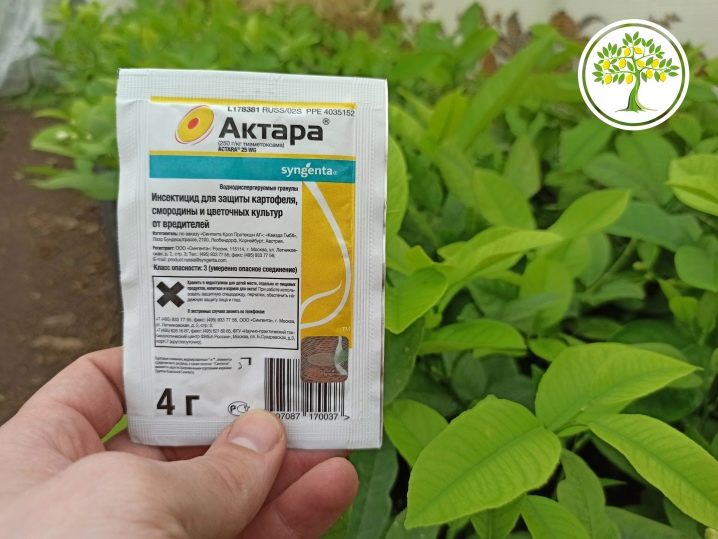













The comment was sent successfully.